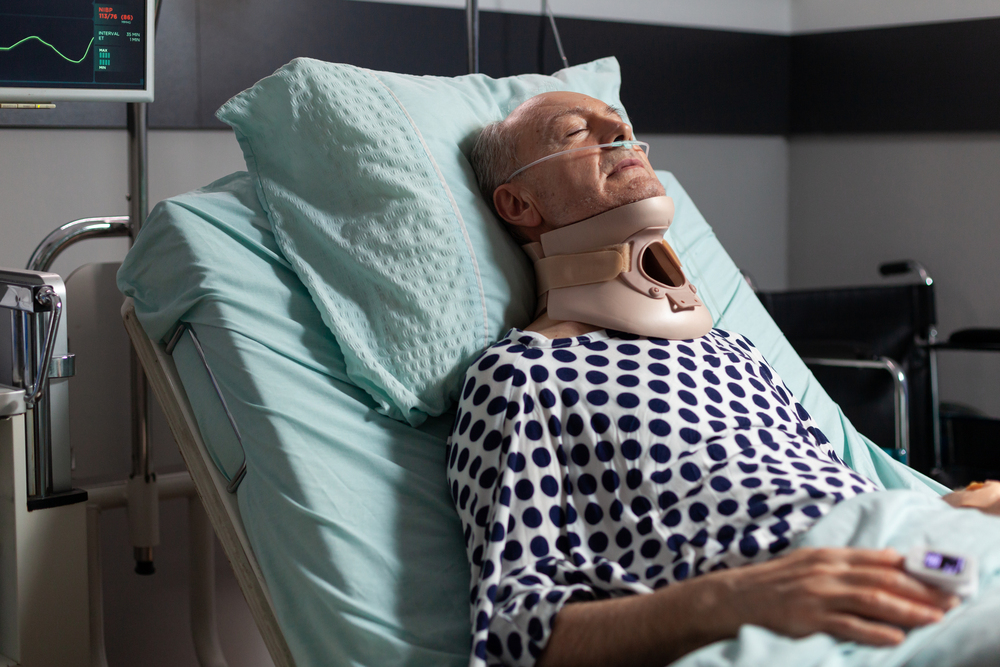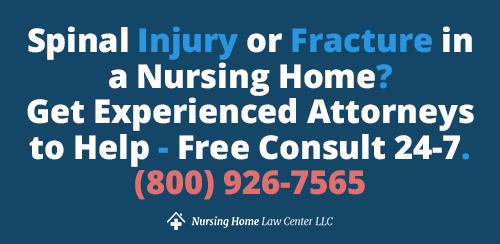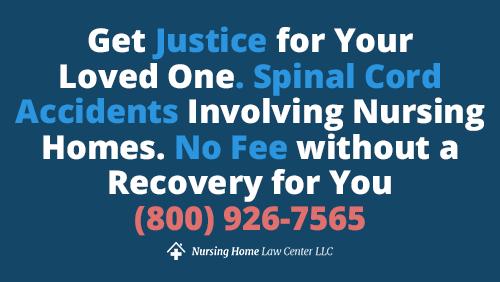The Nursing Home Law Center is committed to providing the legal resources necessary to hold negligent facilities accountable.
Broken Neck Nursing Home Injury Lawyer
A broken neck is one of the most serious nursing home injuries an elderly resident can suffer. Broken necks in nursing homes often result from preventable incidents like falls, improper handling, or even physical abuse.
When nursing home residents experience a broken neck, it may be a sign of elder abuse or neglect. If your loved one has suffered a broken neck injury, Nursing Home Law Center can help.
Verdicts and Settlements Recovered by the Nursing Home Law Center
Our experienced nursing home injury lawyers have recovered millions in settlements, including:
- $1,700,000 settlement for a nursing home resident who sustained a subdural hematoma and fractured hip following a preventable fall.
- $735,000 settlement for a resident who suffered a broken leg and compression fractures to her lumbar and cervical spine after falling from an unattended wheelchair.
- $610,000 settlement for a resident dropped by staff during an improper transfer using a Hoyer lift, leading to serious injuries.

Understanding Broken Neck Injuries
A broken neck refers to a fracture of the cervical spine—the seven vertebrae that support the neck and protect the spinal cord. In nursing homes, spinal injuries often result from falls, blunt force trauma, or sudden neck hyperextension.These cervical fractures can range from mild hairline cracks to life-threatening breaks that may lead to spinal cord injuries or even death. Senior residents are especially vulnerable due to weaker bones and existing medical conditions.
Types of Broken Neck Injuries Seen in Elderly Residents
Elderly patients in nursing homes may suffer several types of broken neck injuries, each carrying serious risks:
Compression fractures happen when the cervical vertebrae collapse under pressure, often from a fall or prolonged pressure on fragile bones.
Hyperextension injuries occur when the neck is forced backward beyond its normal range, leading to damage in the cervical spine.
Odontoid fractures, which affect the peg-like bone (dens) at the top of the cervical spine (C2 vertebra), are common in high-impact trauma or falls.
Cervical spine fractures involve breaks in one or more of the cervical vertebrae and can cause spinal cord injuries, difficulty breathing, and long-term consequences if not treated quickly.

Common Causes of Cervical Spine Fractures Among Nursing Home Residents
Several preventable factors often lead to cervical fractures among residents in nursing facilities, including:
Falls due to mobility limitations and lack of assistive devices or safety rails;
Improper transfers when staff members drop or mishandle patients;
Physical abuse or rough handling during daily care;
Elopement or wandering without supervision, leading to fall accidents;
Spontaneous fractures caused by advanced osteoporosis;
Side effects from sedatives or other medications that increase fall risk;
Dehydration or malnutrition, which weakens bones and muscles over time.
Risk Factors for Broken Neck Injuries Among Elderly Residents
Senior residents face a high risk of broken neck injuries due to a combination of physical and environmental factors. Conditions like osteoporosis make cervical vertebrae fragile and more likely to fracture. Mobility issues, muscle weakness, and difficulty balancing increase the chances of a fall.
Understaffing in nursing homes often means fewer staff members to assist or supervise residents properly. Studies show that nearly sixty percent of nursing home falls happen because residents were not being adequately monitored. Without early intervention and proper safety measures, the risk of serious injuries like cervical spine fractures rises sharply.

Recognizing Symptoms and Diagnosing Cervical Fractures in Nursing Homes
A neck fracture often causes immediate symptoms such as neck pain, bruising, swelling, and tenderness. Some nursing home residents may experience tingling or numbness in their arms or hands, loss of mobility, or even paralysis. If the spinal cord is involved, difficulty breathing may occur.
Diagnosing cervical spine injuries typically requires X-rays, CT scans, MRIs, and neurological exams to assess the damage. If your loved one has suffered a broken neck under unclear circumstances, it is essential to request complete medical records and imaging reports to better understand how the cervical fracture occurred.
The Long-Term Consequences of a Broken Neck in a Nursing Home
A broken neck can leave the elderly with serious, lasting health complications.
Depending on the severity of the cervical spine injury, long-term consequences may include paralysis, chronic neck pain, joint stiffness, and significant loss of mobility. Some patients may develop breathing problems or central cord syndrome, while others face a higher risk of death due to related health complications.
The impact often depends on the resident’s age, overall health, and the extent of the spinal cord damage. Even with proper medical care and physical therapy, recovery from serious injuries like these can be limited.
How Are Broken Necks Treated in Elderly Patients?
Treatment for a broken neck in elderly patients usually begins with immediate medical attention to stabilize the cervical spine. Immobilization with a neck brace is often the first step to prevent further injury.
In more severe cases, surgery may be needed to repair cervical fractures or relieve pressure on the spinal cord. Physical therapy is crucial for regaining strength and mobility.
Delayed or improper treatment can lead to permanent spinal cord injuries, prolonged pain, or even death. Prompt, skilled care is essential to give residents the best possible chance at recovery.
Preventing Broken Necks in Nursing Homes
Preventing broken neck injuries starts with strong fall prevention measures. Nursing homes should provide assistive devices like walkers and wheelchairs, install safety rails on beds, use non-slip flooring, and closely supervise residents during transfers and daily activities.
Regular safety checks and quick responses to call lights can also help prevent fall accidents. A proper care plan must be in place and consistently followed. Adequate staffing is key—without enough trained staff, senior residents face a much higher risk of suffering serious injuries like neck fractures.
What to Do If Your Loved One Has Suffered a Broken Neck in a Nursing Facility
If your loved one has suffered a broken neck in a nursing home, quick action is essential. Request all medical records, imaging results, and incident reports immediately. Take photos of visible injuries, living conditions, and anything that seems unsafe. Keep detailed notes of conversations with staff members and medical professionals.
If you suspect abuse or neglect, report it to your state’s health department or adult protective services. Speak with an experienced nursing home abuse lawyer who can help you protect your loved one’s rights and seek compensation for serious injuries.
Could Your Loved One’s Broken Neck Be a Result of Elder Abuse or Neglect?
A broken neck in a nursing home is often a warning sign of deeper problems. Red flags include unexplained injuries, delays in seeking medical attention, inconsistent staff explanations, or a history of neglect at the facility. Lack of supervision, especially for high-risk elderly residents, increases the chance of fall accidents and serious injuries.
Families should not hesitate to ask hard questions and demand clear answers when a loved one suffers a neck fracture. Nursing home abuse and neglect are too often hidden unless family members take action to uncover the truth.
Who Can Be Held Liable for a Broken Neck in a Nursing Home?
Nursing homes can be held liable when a resident suffers a broken neck due to staff negligence, unsafe conditions, or failure to prevent falls. If staff mishandle residents, ignore care plans, or leave high-risk individuals unsupervised, the facility may face claims for negligence, abuse, and violations of resident rights.
In some cases, failure to provide timely medical attention after a cervical spine injury can also lead to legal action. Holding nursing homes accountable is an essential step in protecting elderly residents from further harm and securing rightful compensation for serious injuries.

Compensation for a Broken Neck Caused by Nursing Home Negligence
When a nursing home’s negligence causes a broken neck, families may be entitled to pursue compensation. This can include payment for medical expenses such as hospitalization, surgery, rehabilitation, and long-term therapy.
Families may also seek damages for pain and suffering, loss of mobility, and reduced quality of life. If the injury forces a move to a different nursing facility or requires in-home care, those costs may also be recovered.
In tragic cases where a loved one’s broken neck leads to death, families can pursue wrongful death damages to help cover their loss.

Statute of Limitations for Nursing Home Injury Claims
Families need to act quickly after a loved one suffers a broken neck in a nursing facility. Each state has its own statute of limitations for filing a nursing home injury claim, often starting from the date of injury or when the injury is discovered.
Some states may pause, or “toll,” the time limit if the injured resident is incapacitated. Delays can make it harder to preserve evidence, gather witness statements, and protect legal rights.
Speaking with a nursing home abuse lawyer early helps ensure families meet important deadlines and build a strong case.
Book a Free Consultation Today
If your loved one has suffered a broken neck in a nursing home, our experienced team is ready to help. At Nursing Home Law Center, we offer a free consultation and work on a contingency fee basis, meaning you pay no fees unless we win. With over $450 million recovered for victims of elder abuse and neglect, we know how to help you seek justice.
Call us at (800) 926–7565 or fill out our contact form to schedule a free consultation with a nursing home neglect and abuse attorney.

